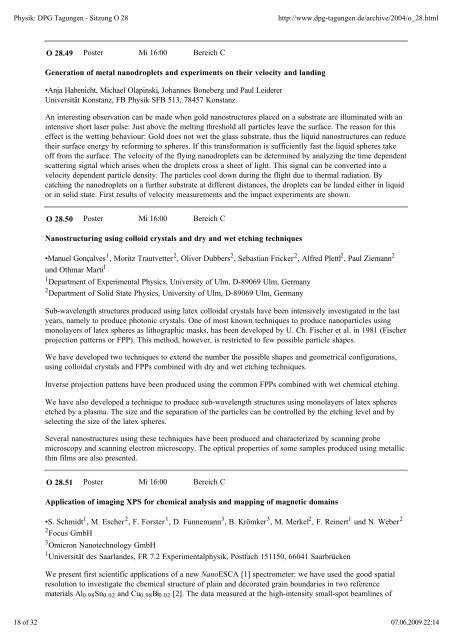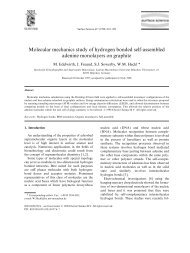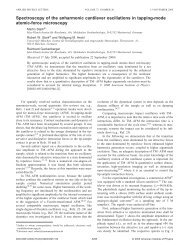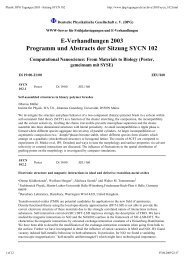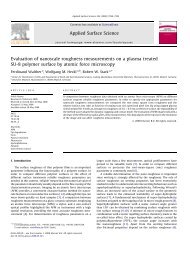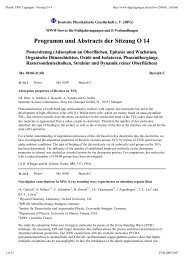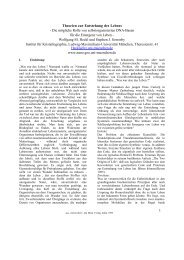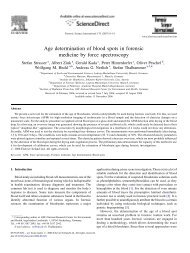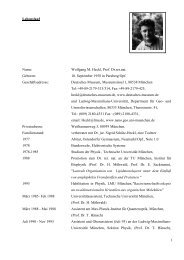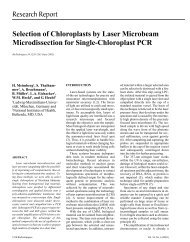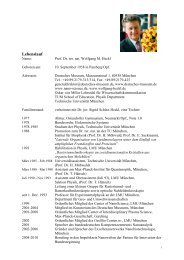Physik: DPG Tagungen - Sitzung O 28 - Nano-science.de
Physik: DPG Tagungen - Sitzung O 28 - Nano-science.de
Physik: DPG Tagungen - Sitzung O 28 - Nano-science.de
Create successful ePaper yourself
Turn your PDF publications into a flip-book with our unique Google optimized e-Paper software.
<strong>Physik</strong>: <strong>DPG</strong> <strong>Tagungen</strong> - <strong>Sitzung</strong> O <strong>28</strong><br />
http://www.dpg-tagungen.<strong>de</strong>/archive/2004/o_<strong>28</strong>.html<br />
O <strong>28</strong>.49 Poster Mi 16:00 Bereich C<br />
Generation of metal nanodroplets and experiments on their velocity and landing<br />
•Anja Habenicht, Michael Olapinski, Johannes Boneberg und Paul Lei<strong>de</strong>rer<br />
Universität Konstanz, FB <strong>Physik</strong> SFB 513, 78457 Konstanz<br />
An interesting observation can be ma<strong>de</strong> when gold nanostructures placed on a substrate are illuminated with an<br />
intensive short laser pulse: Just above the melting threshold all particles leave the surface. The reason for this<br />
effect is the wetting behaviour: Gold does not wet the glass substrate, thus the liquid nanostructures can reduce<br />
their surface energy by reforming to spheres. If this transformation is sufficiently fast the liquid spheres take<br />
off from the surface. The velocity of the flying nanodroplets can be <strong>de</strong>termined by analyzing the time <strong>de</strong>pen<strong>de</strong>nt<br />
scattering signal which arises when the droplets cross a sheet of light. This signal can be converted into a<br />
velocity <strong>de</strong>pen<strong>de</strong>nt particle <strong>de</strong>nsity. The particles cool down during the flight due to thermal radiation. By<br />
catching the nanodroplets on a further substrate at different distances, the droplets can be lan<strong>de</strong>d either in liquid<br />
or in solid state. First results of velocity measurements and the impact experiments are shown.<br />
O <strong>28</strong>.50 Poster Mi 16:00 Bereich C<br />
<strong>Nano</strong>structuring using colloid crystals and dry and wet etching techniques<br />
•Manuel Gonçalves 1 , Moritz Trautvetter 2 , Oliver Dubbers 2 , Sebastian Fricker 2 , Alfred Plettl 2 , Paul Ziemann 2<br />
und Othmar Marti 1<br />
1 Department of Experimental Physics, University of Ulm, D-89069 Ulm, Germany<br />
2 Department of Solid State Physics, University of Ulm, D-89069 Ulm, Germany<br />
Sub-wavelength structures produced using latex colloidal crystals have been intensively investigated in the last<br />
years, namely to produce photonic crystals. One of most known techniques to produce nanoparticles using<br />
monolayers of latex spheres as lithographic masks, has been <strong>de</strong>veloped by U. Ch. Fischer et al. in 1981 (Fischer<br />
projection patterns or FPP). This method, however, is restricted to few possible particle shapes.<br />
We have <strong>de</strong>veloped two techniques to extend the number the possible shapes and geometrical configurations,<br />
using colloidal crystals and FPPs combined with dry and wet etching techniques.<br />
Inverse projection pattens have been produced using the common FPPs combined with wet chemical etching.<br />
We have also <strong>de</strong>veloped a technique to produce sub-wavelength structures using monolayers of latex spheres<br />
etched by a plasma. The size and the separation of the particles can be controlled by the etching level and by<br />
selecting the size of the latex spheres.<br />
Several nanostructures using these techniques have been produced and characterized by scanning probe<br />
microscopy and scanning electron microscopy. The optical properties of some samples produced using metallic<br />
thin films are also presented.<br />
O <strong>28</strong>.51 Poster Mi 16:00 Bereich C<br />
Application of imaging XPS for chemical analysis and mapping of magnetic domains<br />
•S. Schmidt 1 , M. Escher 2 , F. Forster 1 , D. Funnemann 3 , B. Krömker 3 , M. Merkel 2 , F. Reinert 1 und N. Weber 2<br />
2 Focus GmbH<br />
3 Omicron <strong>Nano</strong>technology GmbH<br />
1 Universität <strong>de</strong>s Saarlan<strong>de</strong>s, FR 7.2 Experimentalphysik, Postfach 151150, 66041 Saarbrücken<br />
We present first scientific applications of a new <strong>Nano</strong>ESCA [1] spectrometer: we have used the good spatial<br />
resolution to investigate the chemical structure of plain and <strong>de</strong>corated grain boundaries in two reference<br />
materials Al 0.98 Sn 0.02 and Cu 0.98 Bi 0.02 [2]. The data measured at the high-intensity small-spot beamlines of<br />
18 of 32 07.06.2009 22:14


